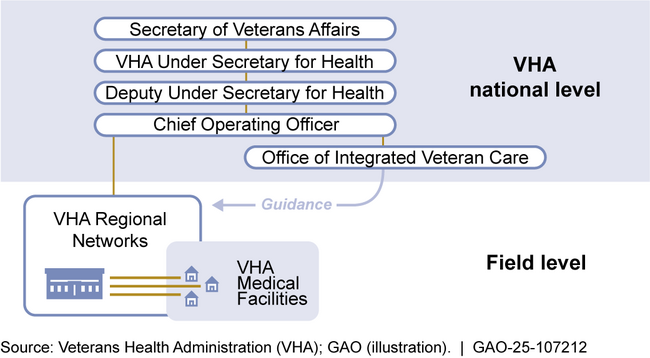Veterans Health Care: Better Communication Needed to Integrate Management of Medical Facility and Community-Based Care
Fast Facts
Veterans who face challenges accessing timely care at Veterans Health Administration facilities have been increasingly referred to community providers.
In 2022, in order to provide seamless access to care, VHA created an office to better coordinate between VHA facilities and community providers.
Later, VA reorganized the office to further address the challenges. But it didn’t clearly communicate changes in priorities and roles to the VHA officials responsible for carrying them out. And some didn’t know where to go for guidance. Clearer communication could help VHA improve veterans’ access to timely care.
Our recommendation addresses this issue.

A hospital waiting room is pictured.
Highlights
Why This Matters
Since 2014, veterans who face challenges accessing timely health care at Veterans Health Administration (VHA) medical facilities have been increasingly referred to community providers to receive care.
As part of an organizational reform to address its progressively complex processes, VHA created the Office of Integrated Veteran Care (IVC) to improve coordination and provide seamless access to care.
GAO Key Takeaways
IVC combined oversight of the management of VHA medical facility and community care into one office. The office established national priorities and initiatives, such as expanding a new process for specialty care appointments. It is also responsible for developing national policy for VHA’s regional networks and medical facilities to guide implementation of initiatives to enhance access to care at medical facilities.
IVC has made several changes to its organizational structure and priorities since it was established. In May 2025, officials said further changes are on hold as the Department of Veterans Affairs undergoes reorganization and workforce reduction that may affect IVC. Congressional stakeholders have raised questions about the potential effects on veteran health care delivery.
The frequent changes have affected officials’ ability to carry out the initiatives at some facilities. They reported that IVC did not clearly communicate changes to its organizational structure, and they did not always know where to seek guidance. They also reported that communication was often one-way, and their input was not solicited when making changes. Clear two-way communication will help officials effectively implement initiatives to ensure veterans access timely care.
VHA Organizational Chart as of January 2025

How GAO Did This Study
We evaluated VHA’s efforts against selected leading agency reform practices identified in prior GAO work. We reviewed documents and interviewed VHA officials from national-level offices, three regional networks, and three medical facilities on IVC’s organizational structure and planned changes.
Recommendations
We are recommending that VHA ensure IVC develops a strategy for clear and continuous two-way communication with relevant employees and stakeholders as the office continues to evolve and makes changes to its organizational structure. VHA concurred with our recommendation.
Recommendations for Executive Action
| Agency Affected | Recommendation | Status |
|---|---|---|
| Veterans Health Administration | The Under Secretary for Health should ensure IVC develops and implements a strategy for conducting clear, direct, and continuous two-way communication with relevant employees—including those at regional networks and medical facilities—and stakeholders as the office continues to evolve and makes changes to its central office organizational structure. (Recommendation 1) |
When we confirm what actions the agency has taken in response to this recommendation, we will provide updated information.
|
